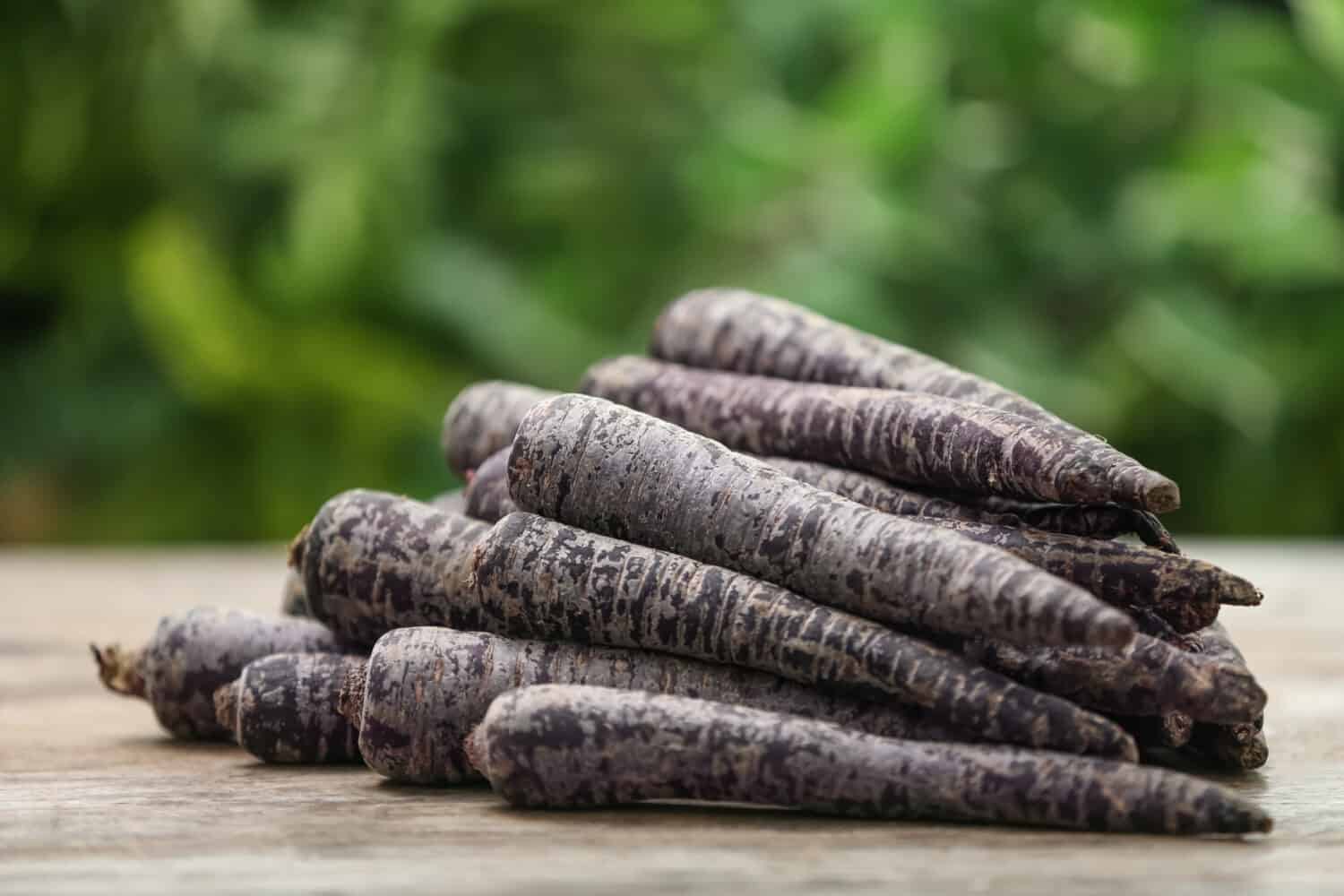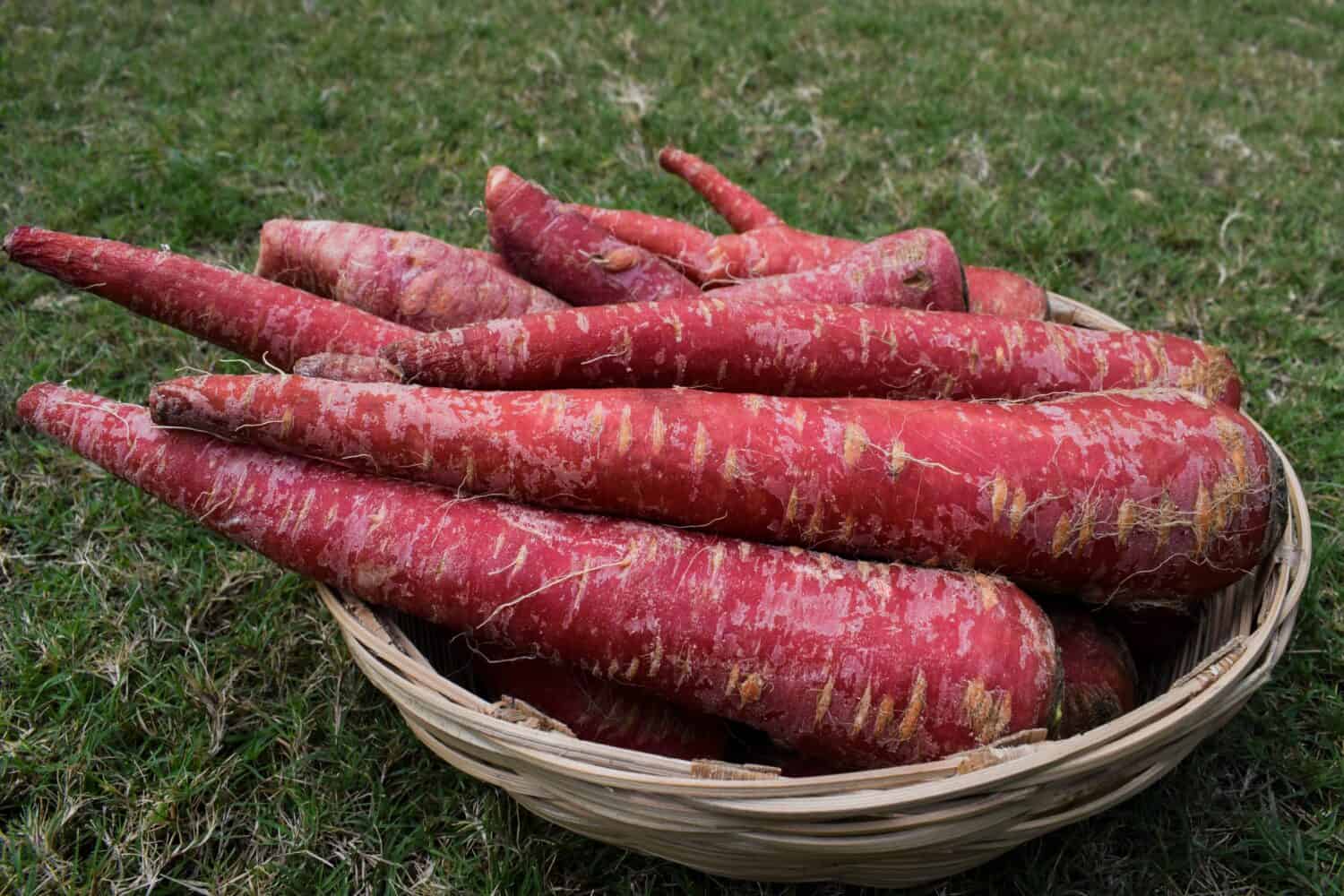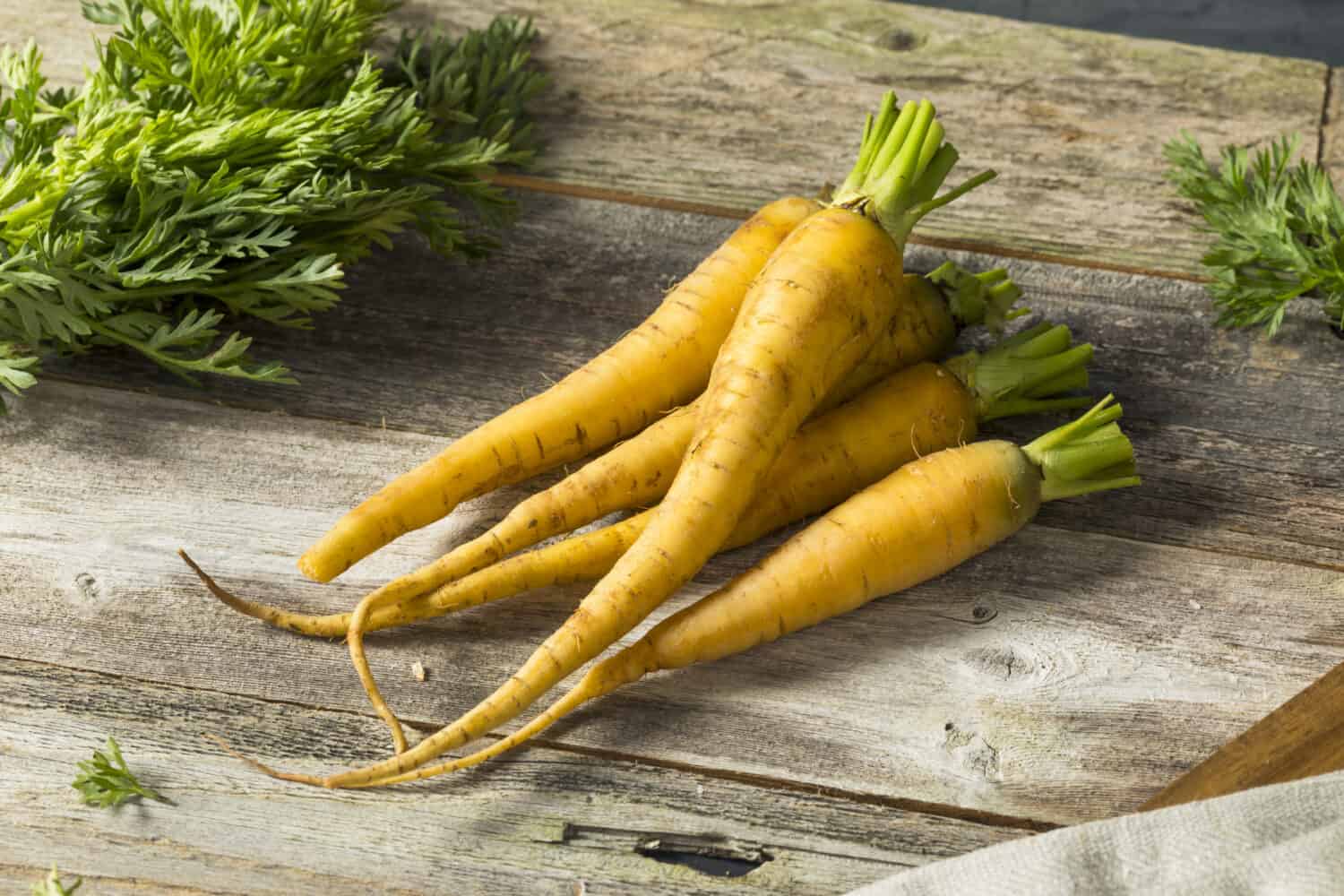“What’s up, Doc?” Bugs Bunny would say in every episode of Looney Tunes, with an orange carrot in hand. When we think of carrots, there is only one color that comes to mind — orange. There are many orange fruits and vegetables — oranges, carrots, pumpkins, mangoes, sweet potatoes, the list goes on. What most people don’t know is there are different colors of this root vegetable. You know this about apples or onions, but bet you didn’t know this fact about carrots!
Now that you know, let’s delve into each color of carrot — explore their history, health benefits, and more. We’ll start with the rarest color and work our way up to the most common.
Black Carrot

Persians and Afghans are believed to be the first to cultivate carrots around 5,000 years ago.
©New Africa/Shutterstock.com
History
The black carrot can be differentiated from the purple carrot because when you cut it, the inside is a purple-black color. Although deep purple is purple throughout, it joins the purple family as its hue is lighter than black carrots. Its roots can be traced back to the Middle East and East Asia. And the black carrot is used in China and India. Its darker color is mostly attributed to its higher concentration in anthocyanins.
Flavors and Uses
When raw, the black carrot can taste bittersweet and have an earthy tang to it. When cooked, it will develop more of a sweeter taste. The black carrot is mainly found and used in countries like China, India, Turkey, and Pakistan. Gajar Kanji, an Indian fermented drink, uses black carrots, but they can also be found in salads, smoothies, and juices.
Health Benefits
Black carrots have an abundance of health benefits. It can improve heart health and ensure good digestive health. Black carrots are good for your eye health and overall can ensure your immune system is stronger. They’re even good for dogs!
White Carrot

Several types of carrots have wild and weird names like fancy Nantes, white satin, Parisian heirloom, kaleidoscope, and purple dragon.
©Katie Kirkland/Shutterstock.com
History
Like all carrots, white carrots originated in the Middle East and slowly spread throughout the world. The white carrot is quite common in South America today.
Flavors and Uses
Although they don’t have pigment, white carrots are sweet and can sometimes be more crispy than other types of carrots. Although these are some of the rarest seeds to find, they are often used in baby food. Carrots can provide good nutrition to babies but to avoid an orange colorization, white carrots are used instead.
Health Benefits
White carrots are beneficial for humans in several ways. Not only are they an excellent source of fiber, but they also provide consumers with great antioxidants to reduce the risk of several types of cancer. It can also lower high blood sugar levels.
Red Carrot

Upon their introduction to Europe, Europeans used carrots for medicinal purposes. The Romans even thought they were aphrodisiacs!
©Rainbow_dazzle/Shutterstock.com
History
Red carrots originated in what is modern-day Afghanistan. It is believed farmers cultivated different colored carrots, like purple, white, and red, by accident. From there, they spread to other regions in Asia and Europe. But they aren’t a very common color of carrot.
Flavors and Uses
People sometimes have perceptions of carrots and their colors. For example, consumers think red carrots are spicy, but that is unequivocally false. Red carrots taste earthy and sweet, and when consumed raw, they are quite crunchy. This red root vegetable appears in many Indian dishes and they are especially good in stews and soups.
Health Benefits
Red carrots contain lycopene, which is a great phytochemical to have to prevent cancer. Other than that, red carrots are good for your heart and eye vision. Overall, they can also help you have a strong immune system.
Yellow Carrot

Not only are carrots 88% water, but they also contain a lot of natural sugars.
©Brent Hofacker/Shutterstock.com
History
Like black and red carrots, as well as purple ones, yellow carrots were first cultivated in the Middle East. They were first introduced as a variety of purple carrots. Before orange carrots were introduced in Europe, European people preferred to eat the yellow carrot.
Flavors and Uses
Yellow carrots are a popular color of carrot used in restaurants. It is seen as something snazzy or fancy to use different types and colors of carrots. Yellow carrots can have a parsley or celery type of taste and are earthy in their flavor.
Health Benefits
Yellow carrots have beta-carotene, xanthophylls, as well as lutein, which are said to be good for your eyes. Medical experts have stated that lutein helps prevent or slow down the speed of macular degeneration and cataracts.
Purple Carrot

Minnesotan Christopher Qualley grew the record for the largest carrot ever grown; it weighed an astonishing 22 pounds!
©ArtCookStudio/Shutterstock.com
History
The purple carrot is the OG, or original, carrot. It’s the one Persians and Afghans farmed and cultivated as early as the 10th century. From there, the carrot spread throughout Far East Asia. China cultivated carrots around the 12th century and carrots popped up in Europe soon after. Although not very popular today, purple carrots are still used in a variety of meals.
Flavors and Uses
Purple carrots are extremely sweet. This color of root vegetable can be used in a variety of ways. For example, you can use purple carrots in soups, smoothies, salads, and juices. They can also be a side dish, too.
Health Benefits
Being the original carrot has its perks. Not only can they claim the title of the first carrot ever farmed and cultivated, but they can also claim the title of the most powerful color of a carrot. The purple carrot has high amounts of anthocyanins. This antioxidant can transform your health and improve it drastically. Purple carrots are good for your heart, your eyes, and your overall immune system.
Orange Carrot

It is rumored the Dutch developed the orange carrot because of the House of Orange, the ruling family in the Netherlands.
©Andrei Porzhezhinskii/Shutterstock.com
History
At last, we come to the most popular carrot — the orange carrot! It is believed that the orange carrot is a hybrid of the original purple carrot. Rumor has it that the Dutch wanted a color to pay tribute to the House of Orange, the ruling family in the Netherlands. But of course, that’s just a rumor because orange carrots were seen in Spain and Germany in the 1500s. Nevertheless, the orange carrot spread to America and became the carrot everyone knows today.
Flavors and Uses
The orange carrot, which tastes sweet, is a very versatile vegetable that can be used in many meals. In its raw form, it can serve as a snack, side dish, or in a salad. When cooked, you can use it as a side dish, but it can also go in soups and stews. You can also use it in juices and smoothies.
Health Benefits
Orange carrots have beta-carotene and these antioxidants help with your eye health. Because your body will turn beta-carotene into vitamin A, it can also help with skin health. Orange carrots have a good amount of fiber, helping your digestive system. Overall, carrots are a superfood that can have an amazing effect on your immune system.
Conclusion
And there you have it, the different colors of carrots: black, red, yellow, white, purple, and orange. Varieties are abundant within each color. Many cultures use different carrots for a variety of uses, from cooking to medicinal purposes. They could have originated in Persia, but they spread all over the world. Orange is the modern, quintessential color of the carrot, but it was purple that started it all.
If you enjoy planting and gardening, having a rainbow-colored cornucopia of carrots can turn your garden into a colorful paradise. And while you explore meals to cook for your family on Sundays, consider buying a different colored carrot or maybe several colored carrots. It will make your salad or stew more colorful. It will be a rainbow of carrots!
6 Different Colors Of Carrots (Rarest to Most Common)
| Carrot Color | Scientific Name |
|---|---|
| Black carrot | Daucus carota ssp. sativus var. atrorubens |
| White carrot | Daucus carota subsp. sativus. |
| Red carrot | Daucus carota subsp. sativus |
| Yellow carrot | Daucus carota subsp. sativus |
| Purple carrot | Daucus carota L. |
| Orange carrot | Daucus carota subsp. sativus |
Thank you for reading! Have some feedback for us? Contact the AZ Animals editorial team.








